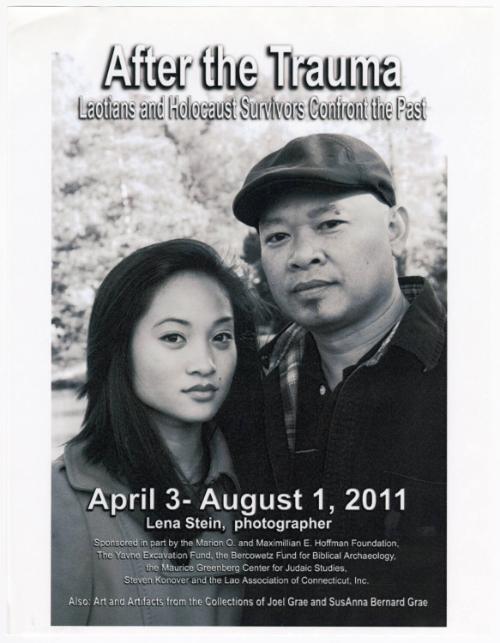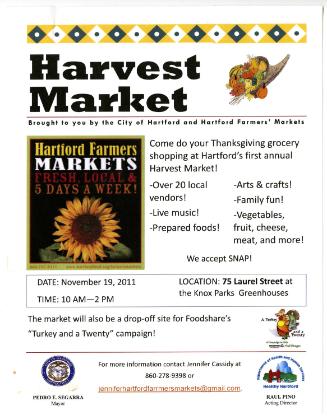Flyer: After the Trauma: Laotians and Holocaust Survivors Confront the Past
Date2011
Mediumpaper
ClassificationsInformation Artifacts
Credit LineConnecticut Cultural Heritage Arts Program collections
CopyrightIn Copyright
Object number2015.196.83.31
DescriptionFlyer, After the Trauma: Laotians and Holocaust Survivors Confront the Past, 2011
NotesSubject Note: In 2011, Manola Sidara from the Lao community along with members of the Greenberg Center of Judaic Studies at the University of Hartford, coordinated the community oral history project "After the Trauma: Holocaust Survivors and Laotian Refugees Confront the Past." An exhibit resulting from the interviews and photographs of the participants was displayed at the University of Hartford.Subject Note: Connecticut was a major resettlement site for Southeast Asians in the 1980's. The Lao population numbers over 3000, living primarily in urban areas such as New Britain, Bridgeport, East Hartford, and Danbury and for a time in the 1990s-2007, in rural eastern Connecticut. While many Lao have found employment in factories, service industries, farming, and trades such as food, they continue to face barriers of language, lack of education, and lower income levels, all against a common backdrop of serious emotional wounds from the Viet Nam War era. Youth aged 10 - 19 years old have been by far the largest age group among Connecticut Southeast Asians. Maintaining young peoples’ awareness of heritage, culture, values, and language is a major goal of Lao leaders and parents. The Lao community sustains its traditional cultural practices in several ways. Several temples around the state provide gathering places where Buddhist monks and nuns offer spiritual services and cultural festivals. The largest temple is in Morris, where the resident monk Khoutavong has created exquisite Buddhist statues and traditional architecture with symbolic carvings, ornamentation, and shrines. Dancer and educator Manola Sidara developed and has directed Lao Narthasin, a traditional dance group now in its third generation of dancers. They perform classical, folk, and social dances that highlight cultural values such as respectful behavior and appreciation for elders. Manola also specializes in creating ceremonial decorations that express wellness, spirituality, and bonding during community celebrations, and she also promotes health and healing through her work as a master chef. The Lao Association of Connecticut formed in 1980 to unite the community and assist in economic development, cultural preservation, education, and health. For many years LAC offered classes in language, history, food and medicine, verbal arts, traditional music, and singing at Jefferson School in New Britain, and the group organizes several heritage festivals each year at the Morris temple that are attended by hundreds of Lao people. Other Lao community groups around the state also develop and present spiritual and cultural programs as well as health initiatives.
Biographical Note: Manola Sidara is a Lao dance educator and community activist whose life has been devoted to serving her community. Born in 1969 in Vientiane, Laos, Manola joined the National Dance School at the age of five, along with her sister. After her family fled Laos, she continued learning traditional dance with master dancer Sone Norasing in Colorado until moving to Connecticut in 1989. From her grandmother and aunts Manola learned to make pah khuane, the ornaments of bamboo leaves and flowers which are part of every Lao ceremony and celebration in both temple and home. She worked as a wedding consultant, organizing all the arrangements for traditional Lao weddings, and became known as a brilliant cake decorator. Manola helped to produce the exhibit The Ties That Bind: Southeast Asian Wedding Traditions at the Institute for Community Research (ICR) in 1995. In 1999-2000 she served as the Bilingual Program Assistant at Garfield School in Bridgeport, teaching ESOL, computers, and cultural awareness to elementary school children both Lao and Latino. Manola taught traditional dance at the Lao Saturday School in New Britain from its inception. With her high-school age students from the school, Manola formed the Lao Narthasin Dance Troupe, instructing the members in classical Laotian dance, folk dances of different ethnic groups in Laos, and traditional values and manners such as respectful behavior, honoring elders, and service to the family and community. The dance group, which has performed throughout Connecticut and Rhode Island at cultural centers and Lao temples, now includes a third generation of dancers. From 1998 to 2001 Manola was the New Britain Coordinator for the Urban Artists Initiative, a statewide training program run by the Connecticut Commission on the Arts and the Institute for Community Research. In 2001 Manola received an award from the Lao Association of CT at New Year for her work with the Lao Narthasin dancers and was selected as a CT Commission on the Arts Master Teaching Artist. In 2011 Manola coordinated the community oral history project After the Trauma: Holocaust Survivors and Laotian Refugees Confront the Past, displayed at the University of Hartford. Manola is also known as a master chef at East West Grille, her award-winning and beloved Lao-Thai restaurant on New Park Avenue in Hartford from 2000-2019, and the East-West Grille Food Truck. Manola is very active in assisting the Lao Temple in Morris, CT, with cultural programming, social service, and providing food for the monks and their ceremonies. For Manola, her tireless activities in dance, education, ceremonial decorations, and cooking all promote wellness, spirituality, bonding, and healing.
Additional audio, video, and photographic materials exist in the archive relating to this community and its artists.
Cataloging Note: This project was made possible in part by the Institute of Museum and Library Services MA-245929-OMS-20.
Status
Not on view2011 March 6
2020
2002-2010
2020












